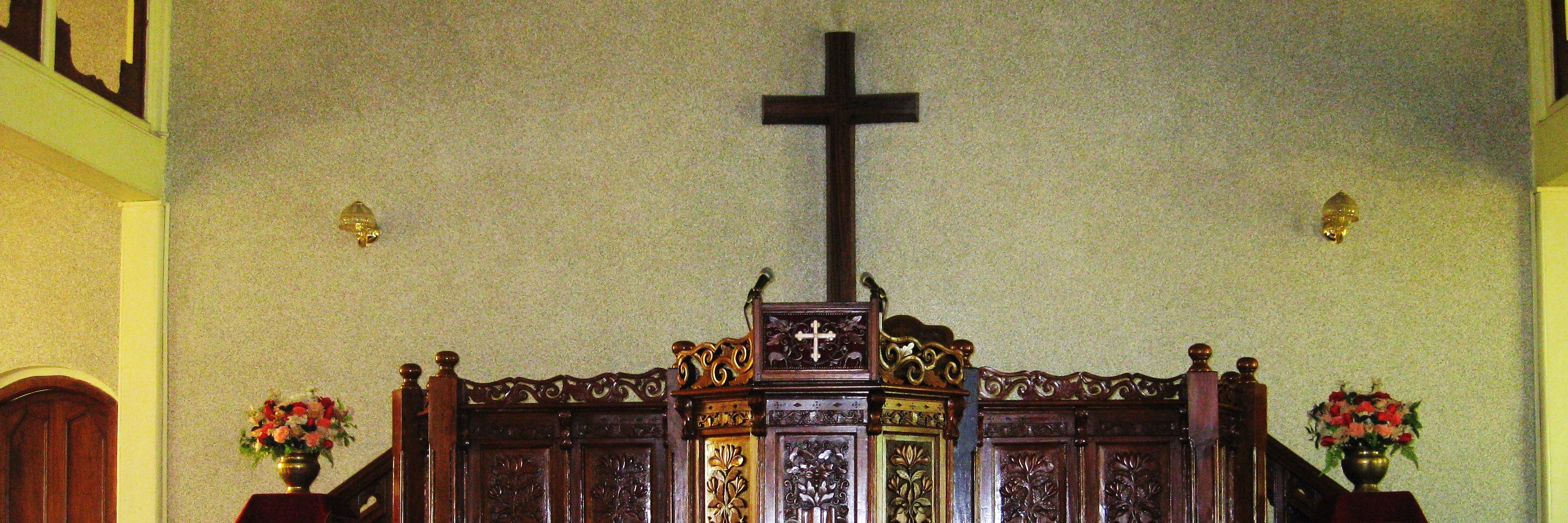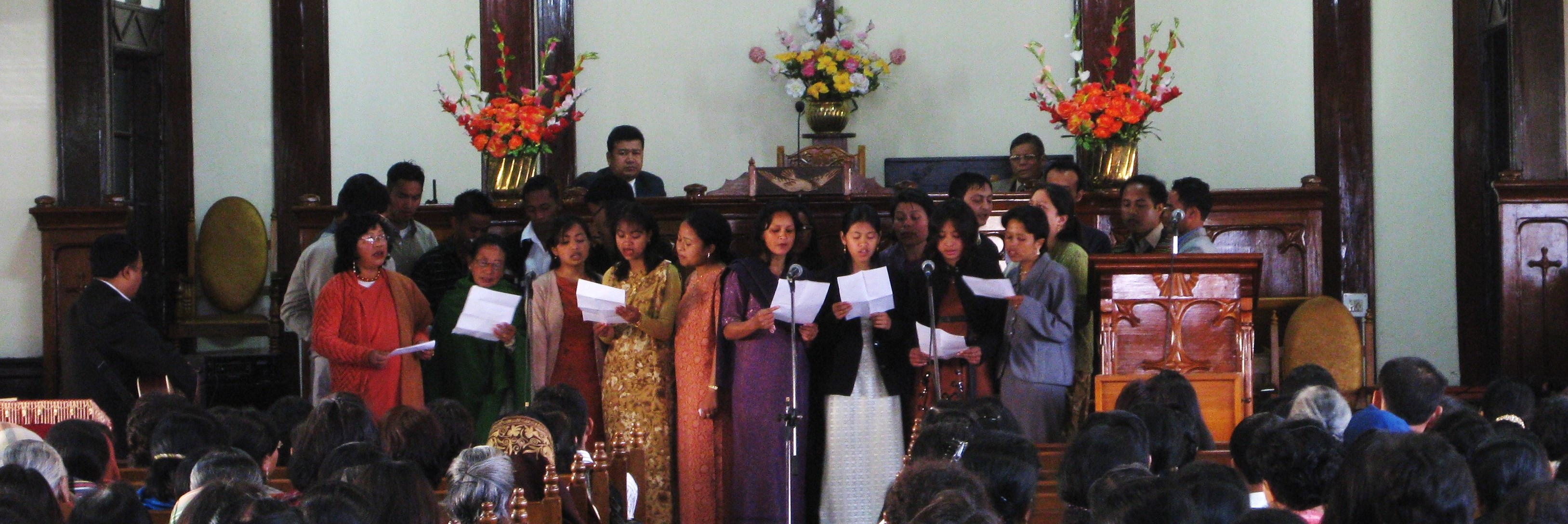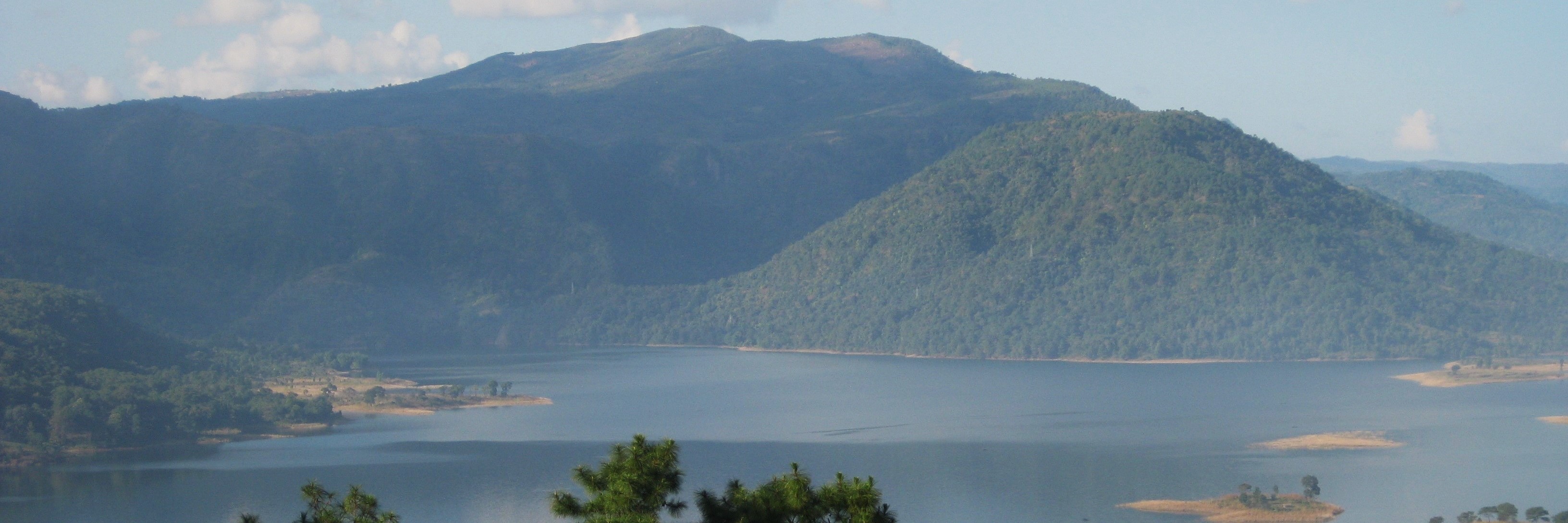Malki Presbyterian Church, home of the “miracle,” sits quietly and unimposing in the middle of a residential Khasi neighborhood, bright orange flowers growing on the metal chain link fence, yellow flowers carpeting the grassy courtyard. As we approach, I marvel at the stacked houses, low-strung power lines, posted plants and washlines. Colorful rugs hang over moldy balcony walls, herb gardens grow next to open windows.
Ten years ago, the churches in the West Khasi Hills District were celebrating the centennial of the 1906 revival – a movement brought to the continent by Welsh missionaries, two years after their own revival. A few weeks after the centennial ceremony, a curious thing happened – local children began experiencing the Holy Spirit. It was the children, in fact, who are credited to starting the actual revival; many reported having visions and seeing angels. In one Jainita Hills schoolroom, activities were disrupted when one student began singing and suddenly, “the whole classroom was anointed” witnesses say, 30-40 students, some lying in a trance, some prophesying, some taken outside to recover from visions.
Many churches reported a strange, glowing dust that would fall upon the congregations while worshipping. Children reported visions of heaven in which they were dancing with the angels and saw the Lord face to face. The children gave similarly amazing descriptions of beautiful gardens, varieties of fruit trees, assorted birds and angels. Some claim to have seen Christ; others to have seen younger siblings or family members they have never met, who recognized them immediately. Some awoke from the vision still waving to whomever they had been conversing with. One child claims to have returned on the back of a horse; two more, on the back of a lion.
Then, on September 5, a wooden cross on the wall of a local church, Malki Presbyterian began to glow, and a strange whitish-gray outline appeared on the front – the silhouette of Christ, many say. The “glowing cross” became an icon of the movement, with lines to participate in services now winding outside the building, many coming to repent, confess sins, or simply to witness the phenomenon. Grown men were seen dancing in the aisles or collapsing at the altar, and many miraculous healings were reported.
***
Today the sanctuary of the church is quiet, creaking and yawning in the sunlight, as if the wood were trying to speak of India’s past. The inside of the church is simple, but regal – rows of wooden pews, a cream-colored interior with sunlight streaming in through the windows. There is a large, ornately-carved pulpit, flanked on either side by modest bowls of roses, and on the wall behind the pulpit hangs the famous dark-wooden block cross.
While Christians in India make up less than 3 percent of the overall population, 70 percent of the Northeast region, including the state of Meghalaya, declared themselves Christian in the last census. Christianity itself is said to have arrived in India as early as 52 A.D. with the apostle Thomas. Thomas reportedly offered his carpenter skills to build a palace for a king named Gundaphorus in the Southwest. Doubting Thomas is said to have performed several miracles and healings before being martyred 20 years later in modern-day Chennai. On Good Friday, Indian nuns still pilgrimage up a hill in Kerala where it was rumored Thomas prayed. He is believed to be buried on St. Thomas Mount in Chennai.
As far as modern Christianity, the Catholic Church officially came to India in the 16th century. The first Protestant mission, the Royal Danish Mission, followed much later around 1700s. The main wave of Protestantism came to India in the 1800s through the rule of the British government. Up until that time, Shillong had a fragmented culture with as many as 30 independent kings in the surrounding area. There was somewhat of a cultural crisis among the Khasis, as they had no written alphabet. When Christian missionaries came in, they developed schools, medical service and a written alphabet. The British subdued the tribal kings and put the area under a single administration, as well as building connecting roads between the neighboring state of Assam and Bangladesh.
Today, most Indian Christians are Catholic, however. While the South, specifically the states of Kerala and Tamil Nadu, are historically the most “Christian” part of India, Baptist and Presbyterian missionaries visited northeast India in the late 1800s, leaving a strong footprint there as well.
***
On Sunday, I am able to visit not one, but two local church services, beginning with the Mizo Presbyterian Church service at 1 p.m. We first have to wait for the Baptists to clear out, as the building is shared. The Baptists have a service at 11:30 and the Presbyterians at 1 p.m. The inside of the church looks like a typical service, except for the deacons and elders sitting off to the side, facing the pulpit. The hymns are unrecognizable, rhythmic drums pounding off to the side. After worship, there is a Bible reading and prayer. The Bible reading is subdued and somewhat timid, but when it comes time for prayer, a young lady winds up shouting vehemently into the microphone, which is modern. The offering is a pouch with handles, and the entire middle section of the congregation stands to sing the “choir” special. Except for the language barrier, it could be a fairly standard Western service.
Perhaps more unusual is the non-denominational New Life City Church (non-denominational) service across town an hour later. I get out of the car and am led toward a drab, concrete structure looking like a parking deck. We descend several flights of concrete stairs and there, in the hollowed-out inside is the open-air service. Dress is casual, with mostly youth within the service. The praise band leads the crowd in English songs such as “Let Everything that Has Breath” and “Arms of Love.” The fact that we are meeting in an unfinished parking deck seems to matter little to the congregation, and I wrap my coat around me at little tighter to ward off the chill.
I later speak with the minister, who started the church approximately 20 years ago. Before being ordained, he told them he did not want to be merely a Baptist minister and build the “Baptist” kingdom.
“God is not really interested in denominations,” he told them. “God is interested in building his kingdom.”
The reverend says he chose Shillong for his ministry because he feels it is the center of education for the Northeast regions. He insists that the services be in English for these same reasons.
“From here we can reach out to the entire northeast region,” he says. “The Bible tells us to go into all the world and preach the gospel. Definitely that has something to do with the language you use,” he says.
I ask him why he thinks Christianity has caught on so well in Meghalaya, but not other parts of India.
“Culturally speaking, Northeasterners are not from a Hindu background – at best they are ‘animistic’,” he says.
***
The next day, Lorna and I visit Cherrapunjee, a series of hills and streams dubbed by the Welsh as Scotland of the East. Cherrapunjee is officially known as the wettest place on earth; the average annual rainfall is 11,932 mm. From March to October, the water runs down the rock cliffs and floods the plains of Bangladesh. During the rains, the streams and falls are gurgling pools of water spilling over lush, green fauna of the mountainside. From November to February, however, the creek beds are dry and the falls dry up to mere ribbons of water.
Lorna and I sit down on a flat rock cliff and eat a picnic lunch – salami and mustard sandwiches, chips, banana bread, sliced apples, butter cookies and water. As we eat, we look over the Indian border of India and down onto the plains of Bangladesh. Lorna then shows me around the park, trying to explain the stories behind each of Cherrapunjee’s many landmarks. She also explains one of the most famous legends, the Khasi legend of Kwai.
Kwai, as it is called, is a three-part combination of betel nut, betel leaf and lyme, chewed together like tobacco, she says. The legend begins with a friendship between a rich man and a poor man. After dining at his rich friend’s house, the poor man feels he must repay the invitation as a matter of honor, to the chagrin of his poor wife.
“Having nothing to serve, she tries to borrow food from the neighbors, but they have lent the couple so much food in the past that they all decline. Ashamed over having nothing to serve the rich friend when he arrives, the woman kills herself in disgrace,” Lorna says.
“When the poor man comes home and sees what the situation has done to his wife, as well as the lack of food, he is overcome with grief. He too kills himself in shame. That night, when the rich man arrives for dinner, he sees his friend and his wife dead in the kitchen, no food in the kitchen, and realizes what has happened. He cries out in grief and feeling responsible for the calamity, he too kills himself. The rich man, in all the commotion, left the front door open and that night a thief passing by enters the house. He sees three dead bodies and panics, thinking he will be caught and blamed for the deaths. He decides to kill himself before he can be accused of the murders.”
The following day, the townspeople happen upon the scene and discover the bodies. They take the matter to the Khasi “Creator” to make sure nothing like this tragedy ever happens again. In his wisdom, the Creator decides to make an act of hospitality that can be shared by both the rich man and the poor man. He turns the wife into a betel nut, the poor man into a betel leaf and the rich man into calcified lyme. This is mixed or chewed to form a red juice, which symbolizes the thief. The resulting product is called “kwai” and is a household staple to this day among Khasis, similar to coffee or tea.
***
Lorna and I ride back home in the fading light. To save gas, our chauffeur turns off the engine going down long hills and while sitting at red lights. This proves to be a problem on more than one occasion when the car won’t start. We sit stranded for several minutes while the driver hops out and works under the hood, frantically. As the roads are not particularly well lit, I start to worry someone will hit us in the dark.
Finally he has it working and we are on our way. A car pulls up beside us, decorated with flowers and ribbons – the result of an Indian wedding, I’m told. Traditional Indian weddings are infamous, ranging from one-day to multi-day events, depending on the income of the host.
According to tradition, the day before the wedding, friends and family apply pitthi, a flour paste to the bride or groom’s skin for good luck. Intricate designs of henna are painted on the hands, feet and arms of the bride. The next day, the groom makes a grand entrance to the ceremony, arriving in a procession with the groom’s party, family and music. He is met at the door by the bride’s family, and the two families greet each other with garlands.
The ceremony may begin with a prayer to Ganesh, the god of prosperity, for good luck. Then the bride and her family arrive. The bride exchanges garlands with the groom, and her father pours holy water in his daughter’s hand and gives her hand to her husband. The groom’s scarf and bride’s sari are tied together, symbolizing an eternal bond. A priest lights a sacred fire and the bride and groom circle the fire several times, meditating on dharma, artha, karma and moksha. The couple then takes seven steps, repeating a vow with each step:
Step 1: To respect and honor each other
Step 2: To share each other’s joy and sorrows
Step 3: To trust and be loyal to each other
Step 4: To cultivate knowledge and peace
Step: 5 To reconfirm purity, family duties and integrity
Step 6: To follow the principles of dharma and all the seasons
Step 7: To nurture a bond of friendship and love.
They exchange rings, and the groom may apply sindoor to the bride’s part. The two are then blessed by the priest and showered with rice and flowers.
***
That night, climbing into bed, I try to warm my clothes against the heater before wriggling into them. I lay there in the dark, thinking of the car and the ceremony of Indian marriage.
The Bible often uses the analogy of bride and groom to symbolize the relationship between He and his church. To be precise, if our relationship with God is like a marriage, it is probably more like an Indian marriage at times – a deliberate choosing of lifelong commitment. A commitment sometimes deeper and more lasting than a union initiated from passion. A walk around the sacred fire repeating, holy principles:
Step 1: Love the Lord your God with all your heart.
Step 2: Love your neighbor as yourself.
Step 3: Forgive as I have forgiven you.
Step 4: Repent and be baptized for your sins.
Step 5: Your attitude should be the same as Christ Jesus.
Step 6: Do not be anxious about anything, but submit your requests in prayer.
Step 7: Go into all the world, making disciples in my name.
I lie in bed, thinking of fire to warm the bones. I think specifically about the seventh step – known to churches as the “great commission.” I’ve read many a book on callings – the Bible itself is full of them. Moses and the burning bush. Samuel and the audible call in the night. The anointing of Saul and David by Samuel. The calling of Gideon with fleece. Jacob wrestling with an angel. God telling Abraham to leave Ur – that his descendants will be like the stars. Paul on the road to Damascus. On and on, the characters from Sunday School march through my imagination. Noah, Peter, Andrew, Matthew the Tax Collector and Mary. James and John, “fishers of men.”
I’ve met Christians from all over the world, and one of my favorite questions to ask is, “How did you know you were called to [insert place].”
Remember in college asking your married friends when they knew their significant other was “the one” and they said “you just know”? (Totally unhelpful.) That’s how I felt asking missionaries I met about how they received their calling – “You just know.”
For the most part, I could put all the responses in three categories:
- There was no calling.
- There was a calling you can’t recreate. (Ex. God spoke to me through a voice in my head or a sunset. A sermon. My dog.)
- And even, “You don’t need a calling.”
And I wonder, if you pray about it, why does finding your personal calling feel like a riddle you have to solve? Like your specific purpose is somewhat hidden. Then I realize, I guess for the same reason Jesus asked questions. Instead of simply stating the obvious, he wants us to find the answer. To be involved in the discovery process of it.
A traveler’s heart is an inquisitive one – constantly learning, constantly growing. In the distance, I hear Calcutta calling with her unknown streets and unfamiliar ways. I think about the Northeast, a sliver of Christianity in a country where the average percentage of believers is below 3%. A melee of languages, tribal cultures and ethnicities. It’s time to leave the Abode of the Clouds tomorrow and venture to the hot, crowded and dusty streets of West Bengal.
Or start at the beginning: read the full journey here.




